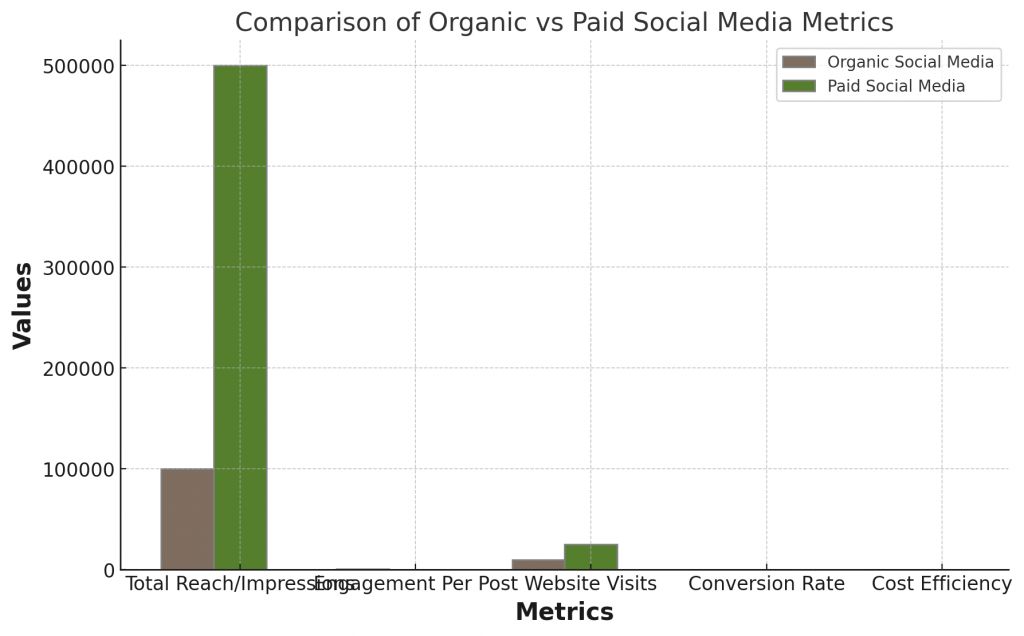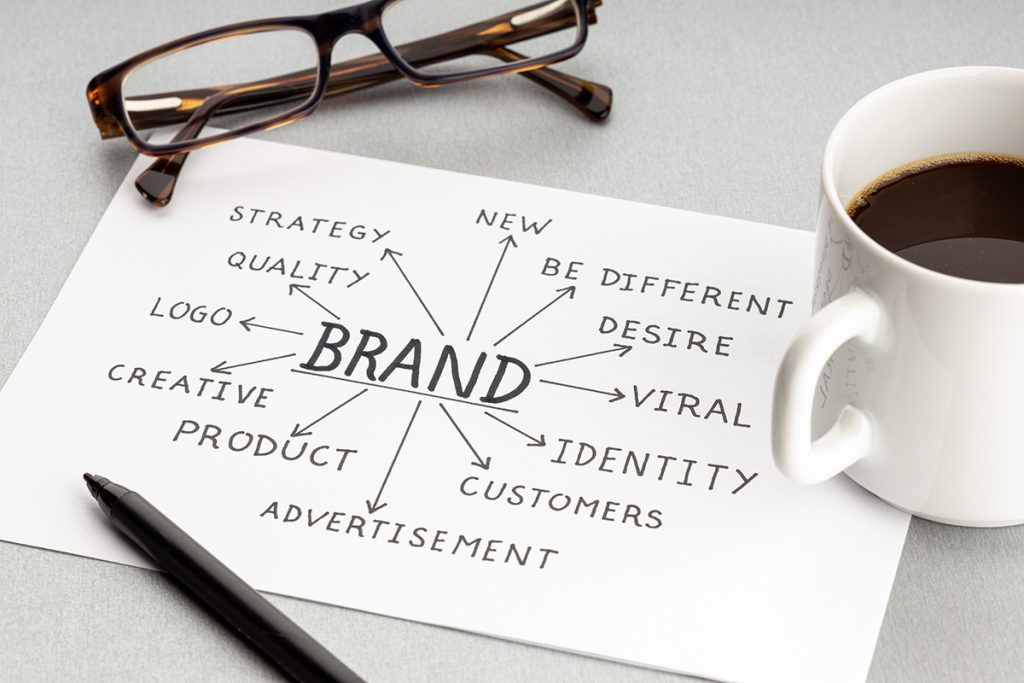Understanding the Landscape: Organic vs. Paid Social Media
The Basics of Organic Social Media
Defining Organic Reach
Organic reach is the cornerstone of any successful social media strategy. It refers to the number of unique users who see your content without paid promotion. This is the essence of ‘naturally’ spreading your message. In the ever-evolving digital world, understanding and maximizing organic reach is crucial for long-term brand building and audience engagement.
Engagement: The Heart of Organic Social
Engagement is the currency of social media. Likes, comments, shares, and saves—all these actions contribute to how your audience interacts with your content. High engagement rates often signal a deeper connection with your audience, suggesting that your content resonates well with them. As a digital marketing expert, I emphasize creating content that sparks conversations and encourages community participation, as this is what truly fuels organic growth.
Content Strategy: Quality and Consistency
A robust content strategy is pivotal in organic social media. This involves crafting high-quality, relevant, and consistent content that aligns with your brand’s voice and audience’s interests. Remember, it’s not just about pushing out content; it’s about creating value for your followers. Whether it’s educational posts, entertaining videos, or thought-provoking articles, your content should aim to inform, engage, and inspire.
The Role of Social Media Algorithms
Social media platforms operate on complex algorithms that can significantly impact your organic reach. These algorithms prioritize content based on factors like user engagement, relevance, and timeliness. Staying ahead means understanding these algorithms and optimizing your content strategy accordingly. For instance, posting when your audience is most active or using trending hashtags can amplify your visibility.
Challenges of Organic Social Media
Despite its benefits, organic social media is not without challenges. The biggest is perhaps the declining organic reach on many platforms, making it harder to connect with your audience without paid strategies. Additionally, creating consistently high-quality content requires significant time and resources. Navigating these challenges requires patience, creativity, and a willingness to adapt to the ever-changing digital landscape.
The Dynamics of Paid Social Media
What Does Paid Reach Really Mean?
Paid reach, in contrast to organic, involves paying to get your content in front of a broader or more targeted audience. This can be through various ad formats like sponsored posts or display ads. The beauty of paid reach lies in its precision and scalability; you can target specific demographics, locations, interests, and even behaviors, ensuring your message gets to the right people at the right time.
Different Ad Formats and Their Impact
Paid social media offers a plethora of ad formats to suit different goals and content types. From story ads that offer a more immersive experience to carousel ads that showcase multiple products, choosing the right format is key to campaign success. Each format has its strengths and works differently across various platforms, making understanding them a necessity for any digital marketer.
Budgeting for Paid Social: Cost-Effectiveness
One of the critical aspects of paid social media is budgeting. How much you spend can significantly impact your campaign’s reach and effectiveness. The goal is to achieve the highest return on investment (ROI) with an optimal budget. This involves understanding different pricing models like cost-per-click (CPC) or cost-per-impression (CPM) and using them to your advantage.
Targeting and Retargeting: A Focused Approach
The power of paid social media lies in its ability to target and retarget audiences. Advanced targeting options allow you to reach specific user segments based on their online behavior, interests, or past interactions with your brand. Retargeting, or reaching out to users who have already shown interest in your brand, can significantly increase conversion rates.
The Speed and Scalability of Paid Campaigns
Paid social media is known for its speed and scalability. Unlike organic strategies that take time to build momentum, paid campaigns can generate immediate results, making them ideal for short-term goals like promotions or event marketing. The scalability factor allows businesses to increase their reach and impact as their budget grows, providing flexibility and control over their marketing efforts.
The Dynamics of Paid Social Media
What Does Paid Reach Really Mean?
Paid reach is the total number of unique viewers who see your content as a result of paid advertisements. Unlike organic reach, which relies on natural discovery, paid reach ensures that your content is placed directly in front of a targeted audience. This method is particularly effective for new or small businesses looking to establish a presence quickly. The ability to specify demographics, interests, and even behaviors allows for a refined approach that can lead to significant engagement and conversion opportunities.
Different Ad Formats and Their Impact
In the world of paid social media, diversity in ad formats allows for a variety of approaches to engage with your target audience. Story ads, carousel ads, video ads, and sponsored posts each serve unique purposes and cater to different audience preferences. For instance, carousel ads are excellent for showcasing multiple products, while video ads can be more engaging and story ads offer a more immersive experience. Understanding the strengths of each format is crucial to maximizing the impact of your paid campaigns.
Budgeting for Paid Social: Cost-Effectiveness
Budgeting is a critical component of paid social media. The cost structure, typically based on cost-per-click (CPC) or cost-per-impression (CPM), demands strategic planning to ensure optimal use of resources. A well-planned budget not only controls expenditure but also maximizes reach and engagement. The key is to start with a clear understanding of your campaign goals and allocate funds in a way that aligns with these objectives, whether it’s brand awareness, lead generation, or direct sales.
Targeting and Retargeting: A Focused Approach
One of the most powerful features of paid social media is its ability to target specific segments of the market. This precise targeting allows for a more efficient use of your advertising budget, ensuring that your message reaches the most relevant audience. Retargeting takes this a step further by focusing on individuals who have already shown interest in your brand, thereby increasing the chances of conversion. Such a focused approach is invaluable in driving higher ROI and fostering brand loyalty.
The Speed and Scalability of Paid Campaigns
Paid social media campaigns are known for their quick setup and ability to scale rapidly. This speed and scalability make them ideal for businesses that need to respond quickly to market changes or wish to promote time-sensitive events. With the ability to adjust budgets and targeting criteria on the fly, paid campaigns offer a level of flexibility and control that is unmatched in the realm of organic social media. Whether you’re a small business or a large corporation, the agility of paid social media can be a significant advantage in today’s fast-paced digital environment.
Comparing Organic and Paid: Metrics That Matter
Reach and Visibility
Organic Reach: Natural but Limited
Organic reach in social media is about how far your content can travel on its own merits. It’s a measure of how many people see your content without any paid promotion. This kind of reach is critical for long-term brand building and establishing trust with your audience. However, it’s important to note that organic reach can be limited. With social media platforms constantly tweaking their algorithms, it’s become increasingly challenging for organic content to find its way into users’ feeds.
Paid Reach: Amplified and Targeted

Paid reach, on the other hand, is all about amplification and precision. By investing in paid social media, you can ensure that your content is seen by a larger and more targeted audience. Paid reach allows you to break through the noise and get your message in front of the people who are most likely to be interested in your products or services. This approach is especially effective for short-term campaigns or when trying to quickly boost your brand’s visibility.
Engagement and Interaction
The Organic Connection: Building Relationships
Engagement in the context of organic social media is about creating a genuine connection with your audience. This can be achieved through compelling storytelling, interactive content, and by fostering a sense of community. High engagement rates on organic content often indicate a strong brand affinity and a loyal follower base. However, achieving this level of engagement requires consistent effort and a deep understanding of your audience’s interests and preferences.
Paid Interactions: Driven by Investment
With paid social media, engagement is often a result of strategic investment. Through targeted ads and sponsored content, you can drive specific actions, such as clicks, likes, or shares. While the engagement might not always be as ‘organic’ as with unpaid content, it can be highly effective in driving certain marketing objectives, like increasing website traffic or generating leads.
Conversion and ROI

Tracking Organic Conversion: Challenges and Insights
One of the most significant challenges with organic social media is tracking conversions and measuring ROI. Because the path from a social media post to a conversion can be indirect, it’s often hard to pinpoint the exact impact of organic social efforts. However, when done right, organic social media can lead to higher-quality leads and conversions over time, as it’s built on the foundation of trust and relationship-building.
Measuring ROI in Paid Social Media
In contrast, paid social media offers more straightforward methods for tracking conversions and calculating ROI. With the ability to set up specific conversion tracking, you can directly link your paid campaigns to business outcomes. This makes it easier to evaluate the effectiveness of your campaigns and make data-driven decisions. However, it’s important to balance short-term conversion goals with long-term brand building, which is where the integration of both organic and paid strategies becomes critical.
Incorporating Comparative Data and Analysis

Hypothetical Scenario for Analysis
Scenario Overview and Objectives
Imagine a mid-sized fashion brand launching a new line of eco-friendly apparel. The objective is to maximize brand exposure, engage with a broader audience, and ultimately drive sales. The brand decides to employ both organic and paid social media strategies across platforms like Instagram, Facebook, and Pinterest for a period of three months.
Assumed Metrics for Organic and Paid Social Media
For the organic campaign, the brand focuses on creative content, influencer collaborations, and regular engagement with followers. The paid campaign involves targeted ads, retargeting previous website visitors, and sponsored posts with influencers. We assume the following metrics:
- Organic: 50,000 reach, 5% engagement rate, 2% conversion rate.
- Paid: 200,000 reach, 2% engagement rate, 5% conversion rate.
Analysis of Comparative Data
Charting and Interpreting Reach and Engagement
The organic strategy, while having a lower reach, boasts a higher engagement rate. This suggests a deeper connection with the audience, possibly leading to higher brand loyalty. On the other hand, the paid strategy reaches four times more people but sees less engagement, indicative of its broader but less personal approach.
Visualizing Conversion Rates and ROI
Despite lower engagement, the paid strategy has a higher conversion rate, likely due to its targeted nature. This suggests that while organic strategies are excellent for building relationships and brand identity, paid strategies can be more effective for driving immediate sales.
Insights from the Comparative Analysis
Strategic Implications of Data
The data implies a need for a balanced approach. While organic social media is key for long-term brand building and creating loyal customer bases, paid social media is crucial for driving short-term sales and reaching new market segments.
Real-World Applications and Adjustments
For businesses, this means allocating resources to both strategies. Invest in quality content and community engagement organically, while also setting aside a budget for targeted paid advertisements. Regularly reviewing these metrics can help adjust strategies for optimal performance. For instance, if organic engagement drops, it might signal the need for fresher content or a new approach to influencer collaborations. Similarly, if paid ads aren’t converting as expected, it might be time to revisit targeting criteria or ad creatives.
Strategic Integration: Balancing Organic and Paid
The Synergy Between Organic and Paid Strategies
Leveraging Organic Content in Paid Campaigns
In the digital marketing world, integrating organic and paid strategies can lead to remarkable results. One effective approach is leveraging your best-performing organic content in paid campaigns. This means identifying posts that have naturally resonated with your audience and using them as the basis for paid advertisements. By doing so, you capitalize on content that’s already proven to be engaging, thus increasing the likelihood of success in your paid efforts.
Using Paid Insights to Inform Organic Content
Conversely, insights gleaned from paid campaigns can be invaluable for shaping your organic content strategy. Pay close attention to which types of ads garner the most engagement and conversions. These insights can guide your organic content creation, helping you to produce material that’s more likely to resonate with your target audience. For instance, if a certain style of video ad is particularly effective, consider adopting a similar style in your regular content.
The Role of Testing and Optimization in Strategy Integration
The key to successfully integrating organic and paid strategies lies in continuous testing and optimization. Use A/B testing in your paid campaigns to determine what works best and apply these learnings to your organic content. Similarly, track the performance of your organic posts and see if these strategies can be incorporated into your paid advertisements. Remember, what works today may not work tomorrow, so stay agile and ready to adapt.
Audience Insights and Feedback Loops

Learning from Organic Engagement
Organic social media provides a goldmine of information about your audience’s preferences and behaviors. By analyzing engagement patterns, comments, and shares, you can gain insights into what your audience cares about and how they interact with your brand. This information is crucial for tailoring both your organic and paid strategies to better meet the needs and interests of your audience.
Analyzing Paid Social Data for Audience Insights
Paid social media, with its advanced analytics, offers a more data-driven approach to understanding your audience. Use metrics from your paid campaigns to identify audience segments that are most responsive to your ads. This data can help refine your targeting for both paid and organic content, ensuring that your messaging is reaching the most receptive audience.
By thoughtfully integrating organic and paid strategies, and harnessing the power of audience insights, you can create a comprehensive social media marketing approach that maximizes reach, engagement, and conversions. Remember, the goal is not to choose between organic and paid, but to find the right balance and synergy that propels your brand forward in the ever-evolving digital landscape.
Platform-Specific Strategies
Facebook: A Dual Battlefield
Organic Strategies on Facebook
Facebook’s vast user base makes it an ideal platform for organic reach. The key to success here lies in creating content that encourages user interaction and shares. This could be through thought-provoking posts, engaging with trending topics, or community-building activities like polls and live Q&A sessions. Facebook Groups are also a powerful tool for organic growth, allowing you to create niche communities where you can regularly engage with your audience in a more personal manner.
Paid Tactics on Facebook
For paid strategies on Facebook, the focus should be on targeted advertising. Utilizing Facebook’s robust targeting options, you can deliver ads to a highly specific audience based on demographics, interests, and behavior. Dynamic ads and retargeting campaigns are particularly effective, allowing you to reach users who have previously interacted with your brand, increasing the likelihood of conversion.
Instagram: Visual Storytelling
Maximizing Organic Reach on Instagram
Instagram is all about aesthetics and storytelling. High-quality visuals, engaging captions, and consistent posting are crucial for organic growth. Utilize Instagram Stories to share behind-the-scenes content, and consider using IGTV for longer-form videos. Hashtags play a significant role in discoverability on Instagram, so be sure to research and use relevant hashtags for your industry.
Instagram Ads: A Game Changer
Instagram ads should be visually appealing and blend seamlessly with organic content. Story ads, carousel ads, and sponsored posts can be used to reach a broader audience. The visual nature of Instagram makes it ideal for showcasing products and lifestyle content that can drive both brand awareness and sales.
Twitter: The Real-Time Conversation Platform
Building an Organic Presence on Twitter
Twitter excels in real-time engagement. To build an organic presence, focus on timely content, engage in trending topics, and interact directly with users through replies and retweets. Twitter chats can be a great way to engage with your community on specific topics, increasing your visibility and authority.
Twitter Ads: Quick and Targeted
Paid strategies on Twitter should leverage its fast-paced nature. Promoted tweets, trends, and accounts can increase your reach quickly. Tailoring content to current events or trends can also increase the effectiveness of your paid campaigns.
LinkedIn: The Professional Network
Organic Growth on LinkedIn
LinkedIn is the go-to platform for professional networking. Share industry insights, company updates, and professional advice to grow organically. Engaging with other users’ content and participating in LinkedIn Groups can also help build your professional network and increase your brand’s visibility.
Leveraging LinkedIn Ads
On LinkedIn, paid ads can be used to target professionals and decision-makers. Sponsored content, InMail campaigns, and text ads can be effective, especially for B2B companies looking to increase brand awareness or generate leads.
Emerging Platforms and Trends
Adapting Strategies for New Social Media Platforms
Stay ahead of the curve by keeping an eye on emerging platforms like TikTok or niche networks that might be relevant to your audience. These platforms often offer untapped potential for early adopters.
The Role of Emerging Technologies in Social Media Marketing
Emerging technologies like augmented reality (AR) and virtual reality (VR) are beginning to play a role in social media marketing. Experimenting with these technologies can offer unique and immersive ways to engage with your audience.
By understanding and leveraging the strengths of each social media platform, you can create a well-rounded and effective social media marketing strategy. Keep in mind that each platform has its unique audience and content preferences, so what works on one platform may not work on another. Tailoring your approach to each platform is key to maximizing your results.
Future Trends in Organic and Paid Social Media
The Evolving Social Media Landscape
Upcoming Changes in Organic Social Media
The world of organic social media is continuously evolving. We are likely to see more emphasis on authentic, user-generated content and storytelling as platforms tweak their algorithms to favor genuine engagement over mere visibility. Video content, especially short-form videos, are becoming increasingly popular, and brands will need to adapt to this change by creating more dynamic and engaging video content. Also, the rise of voice search and smart speakers will influence how content is optimized for organic reach.
Innovations in Paid Social Media Advertising
Paid social media is also not static. One of the biggest trends is the increasing use of artificial intelligence and machine learning to optimize ad campaigns. This technology enables more precise targeting and personalization, which can significantly improve campaign performance. Additionally, we are seeing a shift towards more immersive ad experiences, such as augmented reality ads, which provide a more engaging way for consumers to interact with brands.
Staying Ahead: Adaptability and Continuous Learning
Embracing New Technologies and Platforms
Staying ahead in social media marketing means being open to adopting new technologies and exploring emerging platforms. Brands should be ready to experiment with new formats like AR and VR or platforms like TikTok, which have seen explosive growth. Early adoption of these technologies can provide a competitive edge and open up new avenues for engagement.
The Importance of Ongoing Strategy Evaluation
In the fast-paced world of social media, what worked yesterday might not work tomorrow. Regular evaluation of your strategies is crucial. This involves not only analyzing your performance metrics but also staying informed about industry trends and changes in platform policies. Continuous learning and flexibility to adapt are key to success in social media marketing.
The Future of Social Media Marketing: Predictions and Preparations
Looking forward, we can expect social media platforms to become even more integrated into our daily lives. This will create new opportunities for brands to connect with their audiences in innovative ways. We might see more emphasis on community building, increased use of AI for personalized experiences, and even more advanced advertising options as technology continues to evolve. For businesses, this means preparing for a future where adaptability, creativity, and staying informed are more important than ever.
As we navigate these changes, the one constant will be the need to create meaningful, engaging content that resonates with your audience, whether through organic or paid channels. The future of social media marketing is bright, and for those willing to adapt and innovate, it offers endless possibilities.
Frequently Asked Questions (FAQs)
Organic vs. Paid Social Media
What is the primary difference between organic and paid social media?
Organic social media refers to the natural way content spreads across social platforms without any paid promotion. It relies on high-quality content and robust engagement strategies to naturally attract and retain an audience. Paid social media, however, involves investing in advertising to reach a targeted audience more quickly and effectively. The key difference lies in how each approach uses resources – organic uses time and creativity, while paid uses a monetary budget.
How do I choose between organic and paid strategies for my business?
Choosing between organic and paid strategies depends on your business objectives, budget, and timeline. If you’re looking to build long-term brand loyalty and establish a strong online community, organic strategies are essential. However, if you need to drive quick sales, launch a product, or target a specific audience segment, paid strategies are more effective. Ideally, a balanced approach incorporating both strategies works best for most businesses.
Strategy and Implementation
How often should I post organically on social media?
The frequency of posting organically on social media should be dictated by your audience’s preferences and your capacity to produce quality content. As a rule of thumb, consistency is more important than frequency. It’s better to post high-quality content regularly (even if it’s less frequent) than to post mediocre content frequently.
What are some effective targeting techniques in paid social media?
Effective targeting techniques in paid social media include demographic targeting (age, gender, location), interest-based targeting, and behavior targeting (based on online activities). Retargeting campaigns that focus on users who have previously interacted with your brand can also be highly effective. The key is to understand your audience deeply and use the platform’s targeting capabilities to reach those most likely to engage with your content.
Measuring Success
How do I measure ROI in organic and paid social media?
Measuring ROI in organic social media involves tracking engagement metrics like shares, comments, and organic reach, as well as conversions that can be attributed to organic social efforts. For paid social media, ROI is typically measured by cost-per-click (CPC), cost-per-impression (CPM), and the conversion rate of the ads. The ultimate goal is to understand how much value (in terms of engagement, brand awareness, or sales) your investment in social media is generating.
What are key performance indicators (KPIs) for social media marketing?
Key performance indicators for social media marketing vary depending on your goals but typically include metrics like engagement rate, reach, follower growth, click-through rate, conversion rate, and overall ROI. These KPIs help in assessing the effectiveness of your social media strategies and guiding future marketing decisions.
Trends and Future Outlook
What are the upcoming trends in social media marketing?
Upcoming trends in social media marketing include the rise of ephemeral content like Stories, increased use of video and live streaming, the growing importance of social commerce, and the integration of AI for personalized user experiences. Additionally, we’re seeing a shift towards more authentic and user-generated content.
How can businesses adapt to changes in social media algorithms?
Adapting to changes in social media algorithms involves staying informed about platform updates, diversifying your social media presence across different platforms, engaging actively with your audience, and regularly analyzing your social media metrics to understand what works. It’s also crucial to keep experimenting with new types of content and strategies to see what resonates best with your audience.
In conclusion, navigating the dynamic world of social media marketing can be a complex yet rewarding journey. At BrainFeed Solutions, we understand the intricacies of both organic and paid strategies, and our expertise is tailored to help you make the most out of your social media efforts. Whether you’re looking to build a loyal community organically, drive targeted campaigns through paid ads, or find the perfect balance between the two, our team is equipped with the latest tools, insights, and creative approaches to help you achieve your business goals. We’re not just a service provider; we’re your partner in crafting a social media presence that resonates with your audience and drives real results. Let’s work together to turn your social media platforms into powerful assets for your brand’s growth and success.

